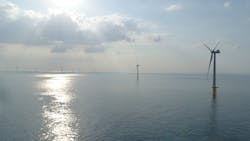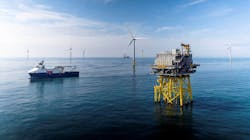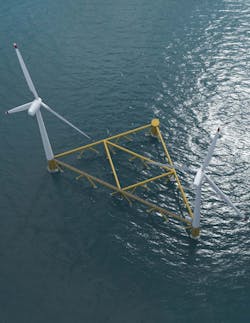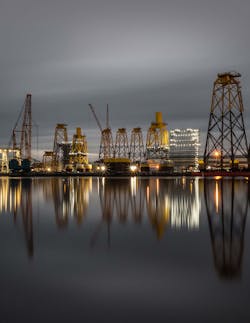Winds of Change: Key Insights Gleaned from Clean Power Projects
A little over 25 years ago, Atkins engineers started working on the earliest designs and requirements for an emerging wind energy market. Fast forward to 2019 and our portfolio now includes more than 375 wind turbine generator foundations, over 1000 operational structures, involvement in four floating concepts, and over 19 offshore substations. From the North Sea, Thames Estuary, English Channel, French, German, and Portuguese coastlines, to distant shores of China, Taiwan, Australia and the United States, we’ve gained some key insights to global energy objectives and drivers that help paint a picture of what's next for the industry.
Government commitment will drive investor stability and entrench offshore wind as a key player in our energy system
We're in a global race to reduce carbon emissions, with the United Kingdom being the first major economy to set the 2050 net-zero target. To reach this ambitious goal, the industry requires commitment from the government to support offshore wind's huge role in our energy system and drive future investor stability. The cost of wind is dropping through industrialization (such as serial fabrication), innovation, and embracing larger turbines; in 2010, prices stood at £140 (US$182.51) per megawatt-hour. Just last year, offshore wind dominated the third U.K. Contracts for Difference (CFD) auction and global energy headlines, with 5.5 GW of projects securing support starting as low as £39.65 (US$51.68) per megawatt-hour. This price sits lower than the current wholesale electricity price in the United Kingdom and adds a further 30% cost reduction to the 2017 CFD prices.
The United Kingdom accounts for 44% of Europe's generating capacity — currently we have just over 10,000 wind turbines, with 2000 of them out to sea. We’re recognized as a market influencer, helping take this expertise globally as big players in the offshore wind market emerge, such as China, the United States, Germany, Taiwan, Netherlands, and France. Global government support will continue to reaffirm that offshore wind is a reliable source of energy to consumers.
Diversity of thought and skillsets: Recruiting for a changing industry
Governmental commitment to offshore wind and a visibility of pipeline projects leads to job creation and security — once projects have secured investment, the industry can tap into regional and local communities, a variety of skills, and innovation. Significant changes in energy, such as costs per megawatt-hour, the 2050 net-zero target, cancellations of major projects, and ever-developing market entrants, mean that innovative and creative ideas are crucial to realizing the industry's long-term success. As well as traditional engineering skills, we also need a workforce fit for the future, with minds and skillsets that challenge convention. We must have the courage to rethink how and who we hire, because seeking opinions from people with diverse backgrounds (experience, industry, and other factors) produces improved results. Previously a typical design team would have been made up of 100% engineers and architects. Future teams could see this ratio change to 25% engineers, 25% data scientists, 25% psychologists, 15% neuroscientists, and 10% social scientists, as full lifecycle projects become more dynamic, using digitalization and artificial intelligence (AI).
Appreciating and embracing complexity: Challenges learned as turbines get bigger
10 years ago, the idea of a 10-MW turbine on a monopile substructure was unimaginable. But with new offshore developments, the only way is up, both in capacity and height. This year the world's largest turbine prototype of 12 MW, GE's Haliade-X, started its year-long testing phase. Once tested and installed, standing at 260-m high from turbine base to blade tip, it will be almost as tall as the Eiffel Tower. Bigger turbines bring new challenges that are not only limited to the height, but also to the structures required to carry their weight, and the vessels to carry, lift, and install such structures out to sea. We've invested a lot of time studying and working with the dynamic nature of turbines, because problems with early offshore installation projects stemmed from not grasping this complexity. That said, these challenges are to be embraced and not steered away from, as larger turbines test the supply chain and push the limits of engineering teams.
The future is afloat
To date, development of offshore wind has focused on shallow water coastal areas (typically up to 60 m), with traditional fixed bottom substructures — monopiles and jackets — dominating. Yet further out to sea, in much deeper waters, is the lure of higher and more consistent wind speeds. These waters are too deep for traditional substructures, opening a new market for floating offshore windfarms (FOW). Over recent years, we’ve seen the cost for fixed bottom offshore wind in Europe tumble, and while the cost of FOW is currently high, we expect to see significant cost reductions in the future as the industry moves from precommercial to full scale commercialization.
Floating wind will be necessary for the United Kingdom to meet net-zero emissions by 2050 and Scotland net-zero emissions by 2045. It will offer a cost-effective pathway to delivering 75 GW of offshore wind in U.K. waters, establish more supply chains, and create thousands of jobs and cross-sector skills especially from those working in offshore oil and gas, and maritime, or where the transition and diversification from oil and gas is needed the most.
We don’t need to reinvent the wheel: The importance of cross-sector skills
While the energy industry is extraordinarily complex and dynamic, we must tap into cross-sector expertise to design and construct better structures. The offshore wind industry may be more newly established when it comes to energy generation, but the skills required to design deep-water structures and platforms are not. From decades of experience in the offshore engineering space, specifically challenging marine environments in the North Sea and Gulf of Mexico, our teams at Atkins boast of some of the most technically skilled individuals in areas such as fatigue assessment, finite element analysis, dynamic analysis, computational fluid dynamics, and hydrodynamics. We use the best of what we have learned along with industry best practices, and splice this with skills, capability, and existing capacity across global client manufacturing capabilities.
From studies for Blyth and Thanet windfarms, to Hywind, the world’s first floating windfarm, and detailed design for Beatrice, the world’s largest offshore windfarm to be installed on jacket foundations opened in July this year, we've come a long way since the industry's early days. Adapting oil and gas sector designs, such as jacket and monopile foundations, corrosion and fatigue analysis, and sharing expertise means we can design future windfarms as economically and sustainably as possible, especially as large energy companies look to transition to renewables. Sector politics, recruitment campaigns, and technology developments will impact the offshore wind market, but it has secured itself as a key component in our drive to a low carbon future.
About the Author
Una Brosnan
Una Brosnan, ATKINS.
Alicia de Haldevang
Alicia de Haldevang, ATKINS.



